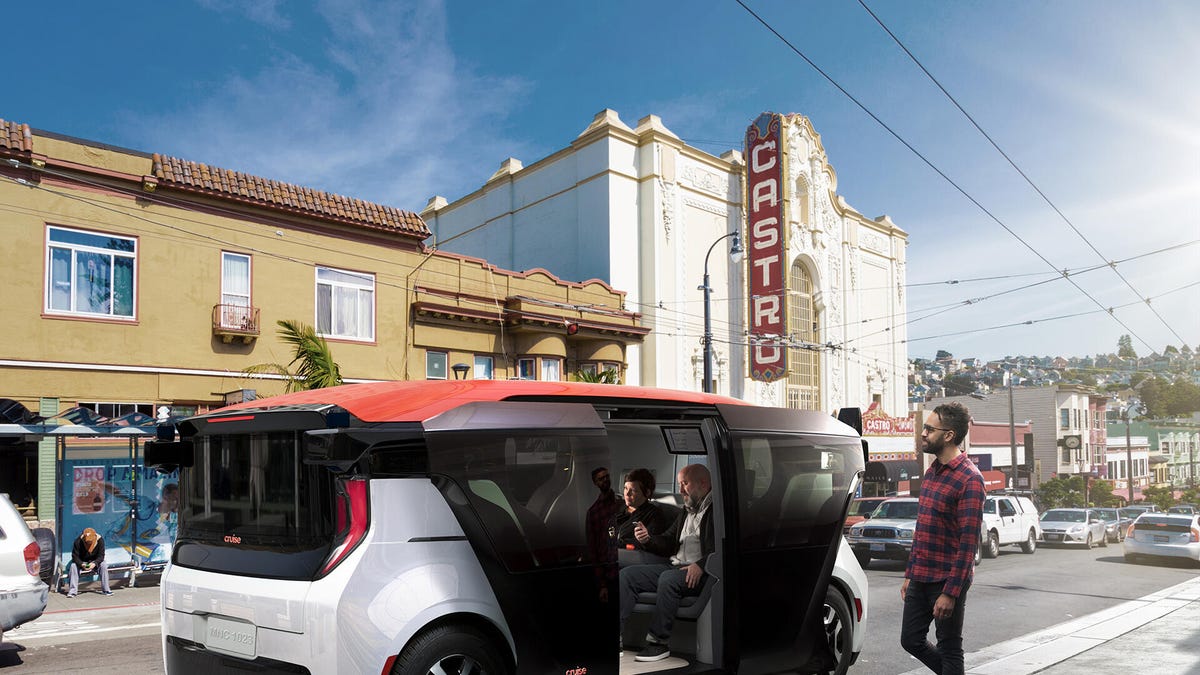Cruise Origin is the electric, driverless taxi of tomorrow
Cruise's boxy, electric people mover ditches the steering wheel and the driver's seat, optimizing for spacious, safe and autonomous urban ride hailing.

Autonomous vehicle developer Cruise debuted the Cruise Origin, its new vision for a totally driverless, emissions-free vehicle of tomorrow, at an event in San Francisco Tuesday night. And yes, it's another futuristic box-on-wheels that I really, really hate looking at, but this autonomous people mover isn't supposed to be sexy. It's meant to be a safe, spacious and city-friendly autocab. The Origin is a driving appliance or, perhaps more specifically, a not-driving appliance built to power an autonomous ride-hailing service sometime in the near future.
Cruise knows a thing or two about ride-hailing. It's been testing a fleet of autonomous Chevrolet Bolt EVs for the past three years and running an autonomous Cruise Anywhere beta test limited to its employees since 2017 -- albeit with a human safety driver on board. Last year, Cruise showcased a fourth-gen version of its self-driving Bolt with no steering wheel, not-so-subtly hinting at its ambitions of Level 5 autonomy.
In many ways, the Cruise Origin is the culmination of those ambitions. Details about the vehicle are still sparse, but here's what we learned at the unveiling event tonight.
The Origin has no driver's seat, just two bench seats that face inward for up to six passengers.
Powering the Origin is a GM-sourced electric motor with the battery pack slung beneath the passenger compartment. We don't have power figures and we don't know range, but these metrics aren't really the point of a low-speed urban shuttle. You probably didn't think about the fuel economy and horsepower of the last Uber or taxi you hailed, and Cruise is smartly reckoning that you probably won't care about the range of the Origin if it can get you where you're going. "This is a service you share, not a product you buy," as Cruise CEO Dan Ammann said multiple times during the evening.
The electric powertrain frees up room in the cabin, making sure that as much of the Origin's fairly compact footprint gets dedicated to the passengers as possible. The upright, boxy profile does the rest. Sliding doors help prevent collisions with cyclists and pedestrians when loading or unloading -- though they'll still have to dodge the people who come spilling out of them at each stop. Inside you'll find generous seating and legroom for four passengers with the folding center armrests deployed or up to six souls if you don't mind scrunching in.
The Origin has no steering wheel, no pedals and no driver seat. It's designed around complete autonomy with the passengers facing inward toward one another. Facing outward is Cruise's suite of sensors and autonomous software, which the company has been honing and developing over three years and millions of miles of testing in San Francisco, Detroit and Scottsdale, Arizona.
You've got your familiar lidars and radars and a new, owllike stereoscopic optical sensor suite that rapidly swivels back and forth, locking onto, recognizing and tracking multiple pedestrians, cyclists and other important details. The Origin features four of these swiveling all-seeing arrays -- one for each vehicle corner -- which can also see in pitch darkness, presumably on the IR spectrum. Cruise calls this blend of sensors Superhuman Sensing, playing up the advantages they offer over human drivers who can only really look in one direction at a time when they're not being distracted.
There are four of these swiveling stereoscopic camera pods, one for each corner.
Eventually, Cruise plans to build a whole lot of these things, so they've gotta be somewhat economically feasible and scalable. The Origin is built around a modular design that should make the sensors easy to repair and upgrade as new sensor technologies develop. Cruise reckons it can build an Origin for about half as much as a traditional EV SUV and keep its vehicles on the road for over 1 million miles each. If they can achieve such a service life, it'll be a solid return on investment. The modular design also means that Cruise could eventually outfit Origins as delivery vehicles or for other purposes, putting the boxes on wheels to work while the city sleeps.
On the consumer side, Cruise isn't ready to talk about how much its eventual ride-hailing service will cost, but estimates that driverless cabs like the Origin can save passengers up to $5,000 per year compared with traditional human-piloted ride-hailing services or owning a car, eliminating parking costs, personal vehicle depreciation, insurance, paying and tipping the driver or wasting time driving yourself. Of course, until we know how much an Origin ride will cost, we can't do the math to see if we agree.
Cruise also isn't ready to talk about when and where the Origin will be produced -- though it does seem confident that it can and will build it. And questions regarding the time frame and launch window for the ride-hailing service that the Origin will support are unfalteringly met with a smile and a "Stay tuned" from Cruise's representatives. I have been told that we can expect more details to trickle out over the coming weeks, so we'll be following this the story of Cruise and its Origin as it develops.

